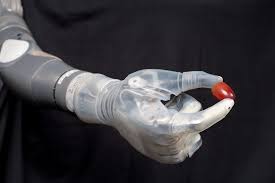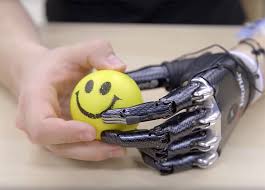Revolutionizing Prosthetics: The Rise of AI-Powered Bionic Limbs
AI-powered prosthetics enhance mobility with smart bionic limbs, offering intuitive movement, real-time adaptation, and improved quality of life.


Advancements in artificial intelligence (AI) and robotics are reshaping the world of prosthetics, transforming what once seemed like science fiction into reality. AI-powered bionic limbs, robotic hands, feet, and other body parts are not only becoming increasingly accessible but are also pushing the boundaries of human capability. These sophisticated devices are giving amputees and individuals with disabilities a new level of independence, dexterity, and control over their movements. The future of AI prosthetics is more than just replacing lost limbs—it’s about enhancing human potential, and opening doors to possibilities we’ve only begun to explore.
The New Era of AI-Powered Prosthetics
Traditionally, prosthetic limbs were simple mechanical devices designed to aid mobility or perform basic tasks. However, in the last decade, technological advances have led to the creation of smart prosthetics—bionic limbs that respond to electrical signals from the brain, offering more intuitive movement and functionality.
Now, with the integration of AI, these prosthetics are reaching new levels of sophistication. AI-powered prosthetics can "learn" from their users, adapting to their unique needs, environment, and movement patterns. For instance, a person using an AI-powered bionic arm can perform tasks like grasping objects or typing on a keyboard with greater precision, as the prosthetic adjusts its movements in real time based on sensory feedback.
How AI Improves Prosthetic Functionality
AI is critical to improving the functionality of bionic limbs in several ways:
Pattern Recognition and Adaptation: AI algorithms analyze the user’s muscle signals to predict and execute desired movements. This makes the prosthetic behave more naturally, almost like an extension of the person’s body. For instance, AI-powered prosthetic hands can recognize different muscle contraction patterns to differentiate between gripping, pointing, or waving motions.
Real-time Feedback: Some advanced AI-powered prosthetics use sensors to provide real-time feedback to users. These sensors detect pressure, heat, or vibration, mimicking sensations a natural limb would experience. This gives users a better understanding of their interactions with the environment, such as how firmly they’re holding an object or where their feet are touching the ground.
Learning Capabilities: AI allows prosthetics to learn and improve over time. The more prosthetics are used, the more data is gathered on the user’s preferences, walking patterns, and common movements. Over time, the AI can predict actions and adjust responses automatically, leading to smoother and more precise motions.
Notable Examples of AI-powered prosthetics
Several cutting-edge AI-powered prosthetic devices are already making waves in the field. Here are some key innovations:
The LUKE Arm: Named after the iconic "Star Wars" character Luke Skywalker, the LUKE arm represents one of the most advanced bionic arms available today. It integrates AI to help users control its movement with electrical signals sent from their muscles. The arm offers individual finger control, allowing users to handle delicate tasks such as picking up small objects or tying their shoes.
The Bebionic Hand: The Bebionic hand is another revolutionary prosthetic, offering users natural control over various movements. Powered by AI, it enables users to perform tasks with finesse, such as holding a cup or typing. The hand can switch between different grip patterns based on the muscle signals it detects, allowing for seamless transitions between different actions.
Ottobock C-Leg: This AI-powered knee prosthetic is designed for individuals with above-knee amputations. The C-Leg uses AI to analyze and adjust the user’s movements in real-time, adapting to terrain changes such as walking on flat surfaces, climbing stairs, or navigating uneven ground. This dynamic response makes the device feel more natural and reduces the risk of falls.
Bionic Feet and Full-Limb Integration
The development of AI-powered bionic feet is equally groundbreaking. These devices are designed to improve the walking experience for people with lower-limb amputations. The Blatchford Linx prosthetic leg is one such example. It integrates AI with hydraulics to create smoother, more balanced steps, adapting to the user's stride and terrain. This gives users a more fluid and confident walking experience, whether they’re strolling on city streets or hiking through rough terrain.
Beyond individual prosthetic limbs, full-limb integration systems are becoming a possibility. These systems combine bionic arms, legs, and other prosthetics to create a seamless, cohesive interface with the human body. The ultimate goal is to create a holistic solution where all prosthetic limbs communicate with each other and with the user’s brain for synchronized and natural movement.
The Future of AI in Prosthetics: Customization and Affordability
As AI prosthetics continue to evolve, one of the biggest breakthroughs on the horizon is customization. AI-driven systems can be tailored to fit the unique needs of each user, making the prosthetic experience more personalized. For instance, algorithms can be trained to understand a person’s specific walking gait, daily activities, and common tasks. This individualization means that prosthetics won’t just replace a limb—they will improve the user’s quality of life in ways beyond the original function of the lost limb.
Another significant change expected in the future is the reduction in costs. As technology advances, AI-powered prosthetics are likely to become more affordable and accessible to a broader population. Today, high-end bionic limbs can cost tens of thousands of dollars, making them inaccessible to many. But innovations in manufacturing, open-source software, and 3D printing may bring prices down in the coming years, making these devices available to more people.
Conclusion
The convergence of AI and prosthetics is revolutionizing the field of mobility and human augmentation. From bionic arms that can type and hold objects with precision to AI-powered feet that offer seamless, natural movement, prosthetics are becoming smarter, more intuitive, and increasingly personalized. The future holds even more promise as full-limb integration systems and customization take center stage, enhancing human capabilities and transforming lives. As AI technology continues to evolve, the line between human and machine will continue to blur, creating opportunities that were once unimaginable.
The age of AI-powered prosthetics is here, and it’s just the beginning.


